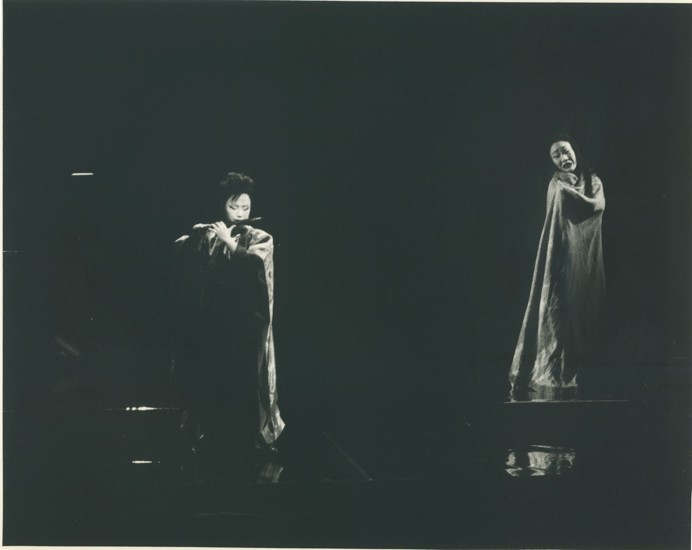水炎伝説 〜回想〜
1990年5月、横笛赤尾三千子の世界「水炎伝説」は東京バリオホールで初演を迎えた。富士ゼロックス大西氏の協力を得て実現。作曲石井眞木、戯曲大岡信、演出実相寺昭雄、共演白石加代子、田中泯、閑崎ひで女、山口恭範、舞台小栗哲家、照明吉井澄雄、田中一光ポスターまで実現。
私は1972年に石井眞木作曲「遭遇II」のアメリカ公演で横笛演奏家としてデビュー。小さい時からピアノを弾いてきた経験から、現代音楽作曲家の作品で、少しずつ仕事の場が増えていった。しかし笛を始めたのは大学に入ってから。伝統の家に育ったわけでもなく、自分の感性だけが頼りのような不安から、自分の笛というものを、しっかりと確立しなければと焦っていた。1977年、何もない所から、ともかく第一回「横笛赤尾三千子の世界」を開催。委嘱作品、古典、即興演奏など、先輩方に胸をかりながら、伝統世界に育たなかった私の笛を、独奏楽器として確立させて行くという方法をとることにした。1985年には念願だったオーケストラとの作品にも恵まれ、ようやくソリストとして認められた。1983年からロサンゼルスに拠点を移し、インディアンの儀式、シャーマンの世界に触れて、笛のもう一つの立脚点として、神楽を意識するようになった。現代音楽としての笛には、どんどん難しい技術が要求され、限界に挑戦し続けることにより、本来の笛の持つ輝きが失われて行くように感じていた。そこで神楽を通して、笛のルーツに立ち返り、笛の内なる声を聞き、笛が持つ本来の力を引き出そうと思い、いくつかの作品を経て至ったのが、水炎伝説だ。
演出は実相寺さんと決めて、話をきいて頂いた。実相寺さんは私の今様を映画のタイトルバックに使って、炎の前で映像にしてくれた人だ。戯曲は、大岡信さん、 作曲は石井眞木さん。白石加代子さんとは以前から共演してみたいと思っていた。幸運にも素晴らしい方達の協力が得られ、大船に乗ったつもりで稽古を待ち構えたが、始まってみると強力な指導者がいない。というか、皆それぞれが一家を成す人で、逆に遠慮し過ぎて進まない。仕方なく、私と白石さんは二人で読み合わせ、音合わせを始めた。ところが白石さんは、演出の鈴木忠志さんから音楽を聞かないようにと指導されてきたという。まったく四面楚歌。ともかく私が主催者だ。ロサンゼルス、ニューヨーク公演も決まった。覚悟を決めて、ただひたすら頑張って、幕を開けた。これが世界初演。ロサンゼルスでは、私が笛で語り、白石さんが言葉で歌うと認められたが、ニューヨークでは、良い公演ではあるが、言葉の壁があって真意が伝わらないとの評。私はがっかりして日本に舞い戻った。月日が経って忘れかけた頃、突然「水炎伝説」再演の話が持ち上がった。照明の吉井澄雄さんと共に、実相寺さんが芸大の新奏楽堂で公演させてくれるという。演奏会形式ではあったが、今度は私がすべての責任を持ち、それを皆さんがフォローして下さり、実相寺さんは撮影までして下さった。石井眞木さんは私の希望を受けて一人打楽器から六人打楽器へと改訂し、指揮もして下さったが、翌年亡くなられてしまった。実相寺さんも亡くなられた。皆さんの遺言のようなこの作品を2016年1月もう一度「新版 水炎伝説」として再演する。笛の内なる声をきき、神楽の庭で自由に羽ばたきたい。水炎という言葉は、私の求める笛の音を表現しきっている。
2015年正月元旦
赤尾三千子
赤尾三千子
LA TIMES記事 9/3/1990
MUSIC REVIEW : L.A. FESTIVAL : 'Water Flame' in U.S. Premiere at Japan America Theatre
September 03, 1990|JOHN HENKEN |TIMES STAFF WRITER
Michiko Akao has been teaching flutes to talk, in ever more dramatic concerts that have become annual events. The process blossomed in "Legend of the Water Flame," a U.S. premiere and Los Angeles Festival program Saturday and Sunday at the Japan America Theatre.
"Water Flame," the creative work of composer Maki Ishii and poet Makoto Ooka, is a sort of reverse melodrama, with a narrator interpreting and enlarging on a story essentially delivered through traditional Japanese flutes. That is very much "The World of Michiko Akao," as the program is supertitled.
Akao's flutes--the ryuteki from Gagaku and the nohkan from Noh--speak with expressive ease at her bidding, highly articulate in a supraverbal language of sonic gestures. The sound can be quite pure, but Saturday at least, Akao emphasized its organic qualities, making living wind and wood audible.
It helps that the story is one of symbolic dualities and elemental contrasts. Accidentally slain by lovers light and dark, Akatoki, the Dawn Women who is the incarnation of transient beauty, enters the Land of the Dead. There she confronts her own nature and that of her elder sister Tokoyo, the Women of the Eternal World, who returns her to the cycle of rebirth and ephemeral glory, "life's delicate flashing."
Ishii has given the two flutes and two worlds discrete vocabularies. For the ryuteki there is a lyrical ascending pattern that peaks in wonderfully bent pitches or smooth glissandos, while the nohkan is all neurotic flutterings and wild shrieks.
Shadowing the music is a spoken part--in Japanese, of course--for actor Kayoko Shiraishi. Part Earth goddess, part storytelling crone, she both interprets and contests the tale of the flutes, and, as Akao makes her instruments speak, Shiraishi makes her words sing in a voice that ranges from childlike piping to low, hoarse croaking.
Mediating all of this, serving up dramatic punctuation, scene-change interludes and moody general accompaniment, is Yasunori Yamaguchi at a battery of percussion. Most evocative was his cideloihos, a large metal ball with a crown of tuned rods created with sculptor Kazuo Harada. Played with mallets, it sounds much like steel-drums, but bowed, it has an icy vocal quality that well served the ambiguous music from the Underworld.
"Water Flame" is staged by Akio Jissoji in an odd amalgam of stylized abstraction, wrenching emotionalism and hammy cliches. His affection for the fog machine amounted to self-parody by the end of the 70-minute, intermissionless show, but he devised effective ritual patterns for Akao and kept Shiraishi physically engaged in a gestural tour de force, hands and even feet popping out of her cloak at unlikely angles.
The flexible unit set is by Hiroshi Tomi, relying on mirrored panels to bounce around abstract patterned projections, and the lighting of Sumio Yoshii, heavy on the blues and stark whites as filtered through the omnipresent fog.
Takayuki Mori designed the simple, functional and elegant costumes, which reflected the respect for both traditional and contemporary perspectives consistent in all elements of the production.
NY TIMES記事 9/11/1990
Review/Music; Japanese Tale of Longing
By JOHN ROCKWELL Published: September 11, 1990
All of this has been turned into prose by Makoto Ooka, a poet, and set to music by Maki Ishii. The entire project was inspired by Michiko Akao, who is a virtuoso on the varied forms of the yokobue, or Japanese transverse flute, and was recited by Kayoko Shiraishi, a well-known actress. Yasunori Yamaguchi played elaborate onstage percussion; Akio Jissoji was the director, and the lavish lighting, sets and costumes were by Sumio Yoshii, Hiroshi Tomi and Takayuki Mori, respectively. The trouble for a Western viewer was that Mr. Ooka provided lots of text, and apart from projected synopses before each scene (which duplicated material in the program), there was no semi-simultaneous translation by supertitles. Thus despite Miss Shiraishi's seemingly powerful oratory, what she was saying remained mostly stylized vocal grimaces in the traditional Japanese manner, devoid of denotative meaning.
That left the look of the production - which was intermittently effective, though compromised by the mechanics of the musical performance - and Mr. Ishii's music. Miss Akao played admirably, as did Mr. Yamaguchi, and the mostly instrumental score proved a characteristic blend of Japanese traditionalism and Impressionist sound-color in the manner so many modern Japanese composers cultivate. But without a clearer notion of what twists in the tale were being conveyed at any given moment, the performance devolved for this listener into exotic atmospherics.

水炎伝説 ロサンゼルス公演